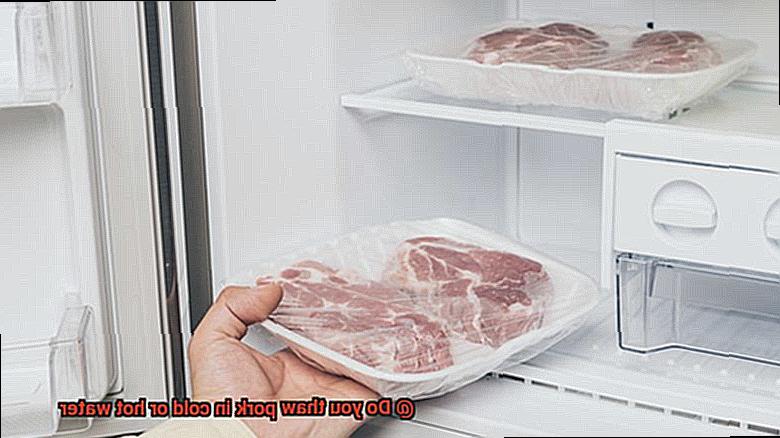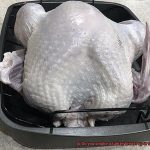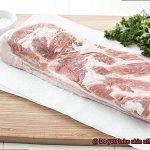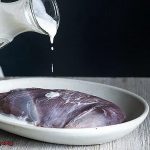Ah, pork – the meat that’s loved by many for its juicy taste and versatility in cooking. But, when it comes to thawing this delicious meat, folks tend to get a little confused. The question on everyone’s lips is whether to thaw pork in cold or hot water. Well, the debate has been raging on for quite some time now.
Coldwater thawing is considered the traditional and safest method of thawing all types of meat, including pork. It’s highly recommended by the United States Department of Agriculture (USDA). However, some people prefer to go down the hot water route for quicker results citing their busy schedules as justification.
In this blog post, we’ll delve deep into both methods of thawing pork and give you all the necessary information you need to make an informed decision based on your preference and available time. We’ll explore the pros and cons of each method, factors to consider when choosing which one to use, and best practices for safely thawing your pork.
So whether you’re team cold or team hot water, we’ve got you covered with tips on how to do it right. That way, your pork will be safe, scrumptious and ready for cooking. Keep reading for more juicy details.
Contents
Why You Should Not Thaw Pork in Hot Water
When you’re in a hurry to prepare pork for dinner, it can be tempting to use hot water to thaw it quickly. However, this method can have several drawbacks that could put your health at risk. Here are some reasons why you should avoid thawing pork in hot water:
- Uneven Cooking: Pork is a delicate meat that requires even cooking to ensure a safe and delicious meal. Thawing it in hot water can cause the surface of the meat to cook, which can lead to uneven cooking when you cook it on the grill or in the oven. This can result in some parts of the meat being overcooked while others are undercooked.
- Bacterial Growth: Pork is a popular breeding ground for bacteria, and thawing it in hot water can create the perfect environment for them to thrive. If the meat is not cooked immediately after thawing, bacteria can multiply rapidly, leading to food poisoning and other health risks.
- Texture and Flavor Changes: Pork has a delicate texture and unique flavor that can be compromised by exposing it to high temperatures. Thawing it in hot water can cause the meat to become tough and dry while also leaching out some of its flavor.
It’s best to thaw pork using cold water or leaving it in the refrigerator overnight. By using the cold water method, you can ensure that the meat retains its texture and flavor while also reducing the risk of bacterial growth. Here’s how you can do it:
- Place the frozen pork in a leak-proof plastic bag.
- Submerge the bag in a bowl of cold water.
- Change the water every 30 minutes until the pork is fully thawed.
The Benefits of Thawing Pork in Cold Water
First and foremost, thawing pork in hot water or at room temperature can be a breeding ground for bacteria such as salmonella and E. coli. The last thing you want is a foodborne illness ruining your meal. By thawing your pork in cold water, you can reduce the risk of bacterial growth as it keeps the meat at a safe temperature below 40°F (4°C). This method ensures that your meat is not only safe but also retains its natural flavors and texture.
Speaking of texture, thawing pork in cold water helps preserve the natural moisture in the meat, resulting in tender and juicy pork when cooked. In contrast, defrosting in hot water or at room temperature can cause the meat to lose moisture, resulting in dry and tough meat. Thawing in cold water not only keeps your pork safe from harmful bacteria but also enhances its flavor and texture.
Convenience is another significant advantage of this method. Thawing pork in the refrigerator can take hours or even days, while thawing in cold water takes as little as 30 minutes per pound of meat. This makes it a go-to option for meal preparation when you’re short on time.
How to Safely Thaw Pork in Cold Water
Thawing pork in cold water is the best way to defrost it quickly and safely. Here are five steps you can follow to safely thaw your pork in cold water:
Seal the Pork in a Leak-Proof Bag
To prevent any bacteria from contaminating the meat while it thaws, seal the frozen pork tightly in a leak-proof plastic bag.
Fill a Large Container with Cold Water
Fill a large container with cold water. Make sure that the water is cold, not warm or hot, as hot water can partially cook the meat and promote bacterial growth.
Submerge the Bag of Pork in Water
Gently place the sealed bag of frozen pork into the container of cold water. Ensure that the entire piece of pork is covered with water, and weigh down the bag with a heavy object to keep it submerged.
Change Water Every 30 Minutes
Change the cold water every 30 minutes to prevent bacterial growth and keep the meat at a safe temperature. You can also place a plate or weight on top of the bag to keep it fully submerged in the water.
Check for Doneness
Once your pork is fully thawed, check for doneness by using a meat thermometer. The internal temperature of pork should be at least 145°F (63°C) before it is safe to eat.
It’s important to note that thawing pork at room temperature or in hot water is not recommended as it promotes bacterial growth and increases the risk of foodborne illness. Always use cold water or thaw your pork in the refrigerator for best results.
Thawing pork in cold water is a safe and effective method that requires proper handling and frequent water changes to ensure that the meat remains at a safe temperature. Once your pork has fully thawed, it should be cooked immediately or stored in the refrigerator for no longer than two days before cooking. Remember, thawed pork should never be refrozen as this can cause bacterial growth and foodborne illness.
Other Safe Alternatives for Thawing Pork
When it comes to thawing pork, there are various safe and effective methods that you can utilize. Besides the cold water method, which we discussed earlier, let’s take a closer look at some other options available.
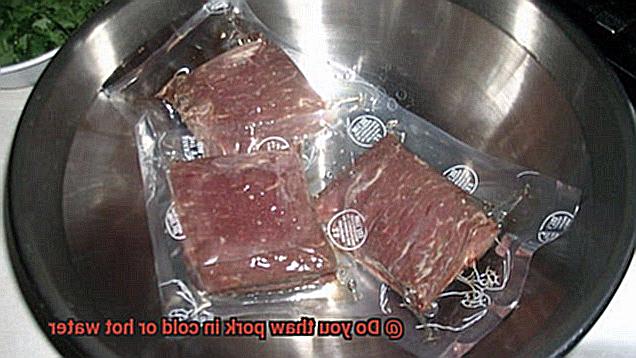
Option 1: Thawing in the Refrigerator
Thawing pork in the refrigerator is an excellent, safe and effective method. It involves a little advanced planning as it may take several hours or even overnight for the pork to thaw completely. However, this slow thawing process ensures that the pork thaws evenly and stays at a safe temperature throughout the process.
To use this method, place the frozen pork in a container or on a plate and put it in the refrigerator. Be sure to place it on the bottom shelf to prevent any juices from dripping onto other foods. Allow several hours or overnight for the pork to thaw completely before cooking.
Option 2: Thawing in the Microwave
The microwave is a quick and convenient option to defrost pork. However, it’s important to use caution when using this method because if not done correctly, it can result in uneven thawing or even partially cooked meat.
To use this method, place the frozen pork on a microwave-safe plate and use the defrost setting. Rotate the pork frequently to ensure even thawing and check it frequently to ensure that it doesn’t start cooking.
Option 3: Thawing in Cold Water
Submerging frozen pork in cold water is another safe and effective way to defrost it quickly. This method requires more attention than using hot water, but it’s still faster than thawing in the refrigerator.
To use this method, place the frozen pork in a sealed plastic bag and submerge it in cold water. Be sure to change the water every 30 minutes to keep it cold and make sure that the pork stays submerged. It’s important to note that this method can take up to an hour or more depending on the size of the pork.
It’s crucial to choose a thawing method that works best for you and always follow food safety guidelines to prevent foodborne illness. Some additional tips to consider include:
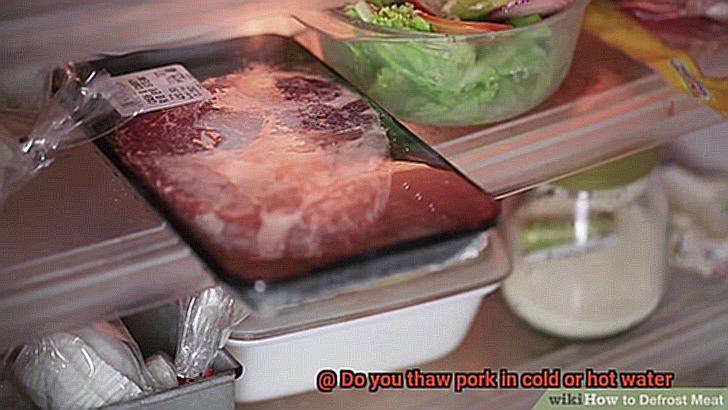
- Avoid using hot water as it can cause uneven thawing and increase the risk of bacteria growth.
- Never refreeze thawed pork unless it has been cooked.
- Always cook pork thoroughly to an internal temperature of 145°F to kill any harmful bacteria.
Common Mistakes to Avoid When Thawing Pork
It’s crucial to know how to properly thaw your pork before cooking. Thawing pork is a critical step that ensures your meat cooks evenly and safely. However, it’s easy to make mistakes that can lead to foodborne illness or poor quality meat. As an expert in this topic, I’m here to share some tips and tricks to help you avoid common mistakes when thawing pork.
Firstly, one of the biggest mistakes people make is leaving the pork out at room temperature. This method can allow bacteria to grow, which can cause food poisoning. Therefore, it’s best to always thaw pork in the refrigerator or in cold water. Thawing in hot water may seem like a quick and easy method, but it can actually lead to uneven thawing and bacterial growth. So, make sure you avoid this mistake.
Another common mistake is trying to thaw pork using a microwave. Although it can be a quick way to thaw pork, it’s not always the best method. Microwaves can heat meat unevenly, leading to partially cooked spots that can harbor bacteria. Additionally, microwaving can affect the texture and flavor of the meat.
Lastly, never refreeze thawed pork. Once you’ve thawed pork, you should cook it as soon as possible. Refreezing it can cause ice crystals to form, which can damage the texture of the meat and make it less flavorful. Additionally, refrozen pork may not be safe to eat because bacteria can grow during the thawing process.
To avoid these mistakes, plan ahead and thaw your pork in the refrigerator or in cold water. Thawing in the refrigerator is the safest method but requires some patience as it can take several hours or even overnight depending on the size of the meat. On the other hand, thawing in cold water is faster but requires more attention to ensure that the water stays cold and doesn’t warm up too much. You may change the water every 30 minutes to keep it cool.
Food Safety Tips for Thawing Pork
Thawing pork safely is crucial to ensure food safety. Bacteria can grow rapidly in meat that is thawed incorrectly, causing foodborne illnesses. Here are five food safety tips for thawing pork:
Never thaw pork at room temperature
Thawing pork at room temperature can lead to bacterial growth. The outer layers of the pork may reach temperatures ideal for bacterial growth, while the inside remains frozen. This creates potential food safety hazards.
Thaw pork in the refrigerator
The safest way to thaw pork is to place it in the refrigerator. This method thaws the meat slowly and at a safe temperature, reducing the risk of bacterial growth. It is important to plan ahead as it can take up to two days for a large cut of pork to thaw.
Use the cold water method for quick thawing
If you need to thaw pork quickly, use the cold water method. Place frozen pork in a sealed plastic bag and submerge it in cold water. Change the water every 30 minutes until the pork is fully thawed. This method can take anywhere from 30 minutes to three hours, depending on the size of the cut of meat.
Avoid hot water and high-heat microwaving
Do not use hot water to thaw pork as it can cause uneven thawing and increase the risk of bacterial growth. Similarly, microwaving on high heat can cause some parts of the pork to cook while others remain frozen, leading to potential food safety hazards. If you choose to use a microwave, follow the manufacturer’s instructions for defrosting.
Cook or store immediately after thawing
Once pork has been thawed, it should be cooked immediately or stored in the refrigerator for up to two days before cooking. This reduces the risk of bacterial growth and ensures that your food is safe to eat.
The Pros and Cons of Different Methods for Thawing Pork
Before you start cooking, it’s crucial to know the pros and cons of different thawing methods to ensure that your pork is both safe and delicious. As an expert in this field, I have done my research and compiled the following information to help you make informed decisions.
Let’s start with the cold water method. This method is one of the quickest ways to thaw frozen pork, making it a popular choice for those who are short on time. You simply place the frozen pork in a leak-proof plastic bag and submerge it in cold water. However, this method requires constant monitoring and changing of the water every 30 minutes to prevent bacterial growth. If you’re someone who can keep an eye on things, this method can work well for you.
The hot water method is another option that can quickly thaw frozen pork. You place the sealed frozen pork into a pot of hot water and let it sit until fully thawed. This method can be even faster than the cold water method, but it requires constant temperature monitoring to avoid bacterial growth. If you’re not careful, you could end up cooking your pork before it’s even thawed.
Lastly, the refrigerator method is the most recommended option for thawing pork as it’s the safest and preserves the quality of the meat. You simply place the frozen pork on a plate or tray on the bottom shelf of the fridge and allow it to thaw slowly over several hours or overnight. This method takes longer than the other two methods but it’s worth considering if you’re planning ahead for a dinner party or simply have some extra time on your hands.
Conclusion
In conclusion, thawing pork is a crucial step in preparing a safe and mouthwatering meal. The debate about how to thaw pork – in cold or hot water – has been ongoing for some time. However, the United States Department of Agriculture (USDA) recommends sticking to the traditional and safest method of cold water thawing for all types of meat, including pork.
It’s important to note that thawing pork in hot water can lead to uneven cooking, bacterial growth, and changes in texture and flavor. On the other hand, cold water thawing preserves the natural flavors and texture while reducing the risk of bacterial growth. Plus, it’s a quick and convenient option for busy cooks.
If you’re short on time, there are other safe alternatives for thawing pork such as using the refrigerator or microwave methods. But always remember to follow food safety guidelines like never refreezing thawed pork and cooking it thoroughly until it reaches an internal temperature of 145°F.
Avoid common mistakes like leaving the pork out at room temperature or trying to use a microwave to defrost it. Instead, handle your pork safely by frequently changing the cold water when using this method and checking its doneness with a meat thermometer.
Ultimately, choosing a thawing method depends on your preference and available time.

